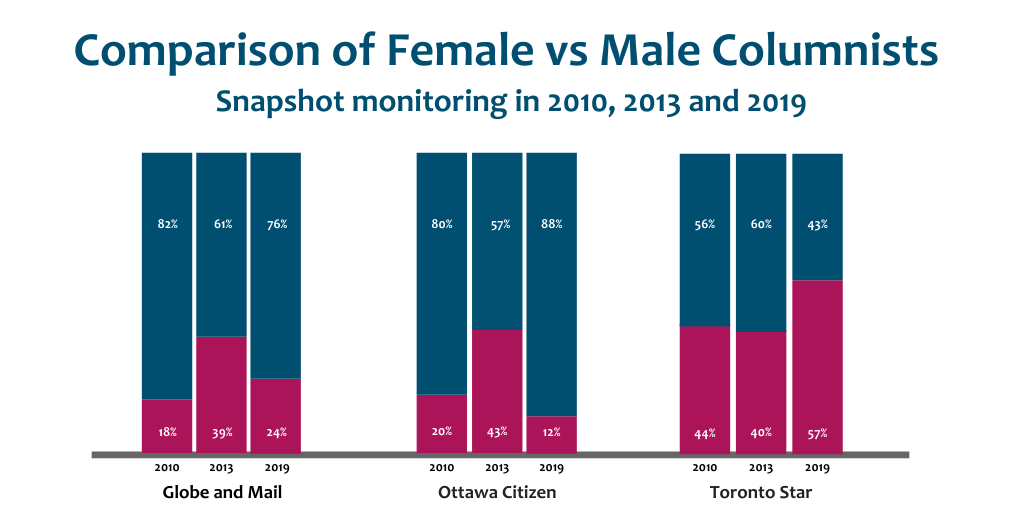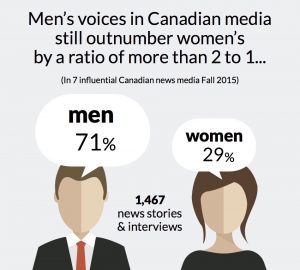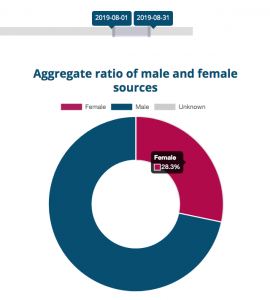Is it true? Does “what gets measured get done”?
That was the impetus for our Gender Gap Tracker, which measures in real time the ratio of women vs men being quoted in Canada’s most influential news outlets. (This matters because diversity of sources is a measure of quality journalism. And the news media should reflect the realities and concerns of the population they serve — 50% of whom are women.)
We hoped that by making the data visible for all to see, we could inspire journalists to do better than they currently are. Bookmark this page to check out how CBC, Global, CTV, The Toronto Star, The Globe and Mail and the National Post are performing on this metric — this week, last month or in 2018 when we started monitoring.

More women’s voices shaping Canada’s public conversations
In the 13 years since Informed Opinions began training women across sectors and fields to share their insights and analysis with the media, thousands of our “grads” have written commentary that’s been published across a wide range of Canadian print and online news platforms. Many more have said “yes” to media interviews that they might previously have declined.
Curious to see if our training impact was translating into moving the needle in an aggregate way, in November 2019, Informed Opinions’ board chair at the time, Nobina Robinson, and advisory committee member, June Webber undertook a month-long content analysis study of the online comment hubs of three daily newspapers. (These typically feature more content than their print counterparts, because space is not at such a premium.)
The coding efforts captured the author, gender, topic, title and affiliation of every opinion piece by both regular columnists and op ed contributors at The Globe and Mail, The Ottawa Citizen and The Toronto Star for the entire month.
The results — when compared with similar research we did in Spring of 2010 and February-March of 2013 — show that we are, indeed, making progress. Here’s what we found:

Over the past ten years, all three papers improved the representation of female contributors to their opinion sections, increasing commentary by women by at least eight per cent, and as much as 16%. And some of the women published in each paper are, indeed, women who’ve participated in our training and/or who are featured in our database.
The data on female columnists (staff or freelance writers who are given a regular platform by the news outlet) revealed a more complicated picture. During the month of November, 57% of the published commentaries in the Toronto Star written by regular contributors were penned by women, up from an already impressive 40% in 2013. In contrast, the percentage of female columnists at both the Ottawa Citizen and the Globe and Mail declined in the same period. From a high of 43% in 2013, the Citizen dropped to 12%. Meanwhile, female columnists in the Globe dropped from 39% seven years ago to 24% last fall.

We reached out to the comment section editors of all three papers to share our findings, gain a better understanding of the editors’ goals, and explore what, if anything, we might be able to do to support a more equitable representation of perspectives.
Scott Colby at the Toronto Star responded immediately, offering candid feedback on his process and priorities. Looking at the print version of his paper, he says, makes clear how well the Star is doing in featuring women’s perspectives. Columnists’ bylines are accompanied by thumbnail photos, making it easy to see the gender breakdown. But, he says, he still receives many, many more op ed submissions from men than women, and — given the diversity of Toronto’s population — he’s especially focused on making sure the op eds he publishes reflect the voices of people of colour.
Although Colby sometimes commissions opinion pieces, he says he often finds it especially difficult to recruit female contributors able and willing to comment on Canadian politics, international affairs and financial issues.
Like Colby, Ottawa Citizen comment page editor, Christina Spencer, receives many more unsolicited op ed submissions from men than women, but says that when she’s able to commission pieces — seeking commentary on an emerging issue or breaking story — the women she approaches are as likely to say yes as their male counterparts. But Spencer acknowledges that as part of the Post Media chain of papers, The Citizen inherits many of its columnists from The National Post, the vast majority of whom are male.
Although we didn’t receive a response to our query from the Globe, the reduction in female voices on the columnist side may be partly a function of the recent retirement of Margaret Wente, who previously wrote three times a week. (In our 2010 research, her views made up 40% of the female perspective published on the paper’s comment pages.)
The splintering of news audiences means that legacy news media exert less sway over public discourse today than they did a decade ago. However, comment pages and online hubs remain influential. Politicians and policy-makers pay attention to the ideas shared and positions advocated, and broadcast journalists seeking authoritative guests able to provide context for and analysis on timely issues also turn to opinion spaces.
We have argued elsewhere for the importance of ensuring that such spaces — and news coverage more broadly — provide a diversity of perspectives more generally, and better reflect women’s perspectives in particular. It’s encouraging to see the progress reflected in this most recent research.
We are grateful not only for the essential support of Dr. Maite Taboada and her colleagues at Simon Fraser University, but for the funds provided by the federal department of Women and Gender Equality (formerly Status of Women Canada) that permitted us to publicly launch and promote the tool over the course of its first seven months.
Got women? Canada’s mainstream media inching towards gender parity

A new study reveals not only that women remain significantly underrepresented as subjects and sources in the Canadian media, but that despite increasingly widespread attention to the problem, little has changed in more than two decades.
The research, commissioned by Informed Opinions, shows that men currently account for 71% of all those quoted or interviewed for newspaper articles and broadcast segments.
The independently-conducted study reviewed more than 1,400 articles and broadcast segments from seven Canadian newspapers and media outlets over the course of three distinct monitoring periods between October and December 2015.
The results reveal that women’s voices make up only 29% of those being heard on air or quoted in print.
When individuals who were neither Canadian nor in Canada were omitted from the sample, female representation rose slightly to 32%.
What’s most disappointing is that so little has changed in more than two decades.
Content analysis conducted annually by Media Action between 1990 and 1993 found the number of women quoted or interviewed in the Canadian media rose marginally from 17% to 22%.
However, the ratio of male to female voices in the current study varied considerably from one news outlet to another, suggesting that journalists who make an effort are able to reflect greater diversity of sources and perspectives than those who don’t.
Read the Executive Summary below. Download a PDF version of the Executive Summary here.
Read the full research report: Gender of Sources Used in Major Canadian media
Un résumé est aussi disponible en français
Gender of sources used in major Canadian media
By Marika Morris, Ph.D., Adjunct Research Professor, School of Canadian Studies, Carleton University
Ottawa, Canada – Marika.Morris@Carleton.ca
Executive Summary
Introduction
- The purpose of this study is to provide statistically valid baseline data on the gender of who is quoted in major Canadian media of national reach, so that the same methodology can be applied to a subsequent study in three years’ time to measure any progress made during a period in which Informed Opinions is doing outreach to media and creating tools for journalists for finding female expert sources.
Methodology
- The study examined 1,467 articles and broadcast segments from seven Canadian media outlets/programs with high audience/readership numbers and a national reach (online versions of the Globe and Mail, Toronto Star, National Post, La Presse, CTV National News, CBC The Current and ICI Tout le monde en parle). Only news sections of the online versions of the print publications were reviewed, excluding sports, regional or local news, entertainment, etc. unless stories from these sections appeared in the top headlines.
- During three monitoring periods from October to December 2015, the study collected 15 days of data resulting in a sample of 3,213 persons quoted who had an identifiable gender. Transgender persons were coded as whatever gender they presented as.
Analysis and results
- Male sources quoted accounted for almost three-quarters of all persons quoted (71%), and women were 29%.
- When persons who were not Canadian and not in Canada were removed from the sample, male representation dropped to 68%, which is still over two-thirds of people quoted, and female representation was 32%, about a third of persons quoted.
- There was a statistically significant relationship (p<0.01) between gender and media outlet, which existed whether international sources or Canadian sources only were examined. Public broadcasters did better than the private broadcaster or the print media in terms of representation of women as sources.
- For the full sample, these were the media outlets/broadcasts with the best representation of women as sources, in descending order: ICI Tout le monde en parle (41%), CBC The Current (40%), Toronto Star (34%), La Presse (28%), Globe and Mail (27%), National Post (26%), CTV National News (23%).
- For the Canadian only sample of persons quoted, these were the media outlets/broadcasts with the best representation of women as sources, in descending order: CBC The Current (43%), ICI Tout le monde en parle (42%), Toronto Star (37%), Globe and Mail, La Presse and National Post were tied at 28%, CTV National News (26%).
- Men outnumbered women in every professional category, whether or not the full sample (Canadian and international) or the Canadian-only sample. For the Canadian-only sample, 66% of academics quoted were men, 76% of politicians were men, 70% of unelected government officials were men, 52% of people associated with an NGO were men, 78% of those associated with private business were men, 73% of those quoted from the legal profession were men, 55% of those quoted in the health professions were men, 66% of people quoted as sources who worked in the media were men, 66% of those in creative occupations were men, 88% of police personnel quoted were men, 100% of our sample of individuals associated with sports were men. For every professional/occupational category for which data was available, women were significantly under-represented relative to their numbers in these professions/occupations as recorded in 2011 Statistics Canada data, except in the political category.
- The health professions were the one exception to the trend of the over-representation of men, at least on the surface. In this category, 53% were women, and 47% were men in the full sample, but this declined to 45% women and 55% men in the Canadian only sample. To put this in perspective, Statistics Canada 2011 indicated that women make up 80% of health occupations in Canada, including 58% of professional occupations in health excluding nursing.
- Women are under-represented in a number of occupations in real life, such as in the natural and applied sciences, plumbers, electricians, construction, transport and heavy equipment operation, etc. To deal with the imbalance in the natural and applied sciences, we did not cover science and technology sections of version of print media websites. The latter group (trades, technicians and heavy labour) were not a significantly quoted group in the media, and people in these occupations were coded as a part of the “other” category.
- Of persons in the victim/witness category, 47% were female and 53% were male. In the Canadian only sample, female representation dropped: 44% were female and 56% were male. The ratio of women to men as victim and witness sources exceeded the ratio of women to men in the professional categories, except in the health field. Men are more often presented in the media as experts than as victims or witnesses.
- A gender balance (50% women, 50% men) was recorded for person-on-the-street interviews. The diversity of those interviewed seemed to be dependent on the reporter, with one reporter in particular achieving a good diversity in terms of gender, race and age, and some others, less so.
- The study also made an experimental foray into collecting data on other kinds of diversity. The collection of data on types of diversity other than gender (racial, ethnocultural, linguistic, religious, disability, sexual or gender identity) is problematic because people’s association with these groups is not always known or obvious in print, radio and TV. We collected data on perceived diversity status, but because of methodological difficulties associated with collecting these data, no valid conclusions can be drawn.
- There was no significant statistical relationship between gender and length of time quoted. Once women are quoted, they tend to be quoted for the same length of time as men.
- An analysis was performed using just articles and segments produced by media outlet staff, excluding articles and segments from newswire services or reprinted/rebroadcast from other sources. There was no significant difference, meaning that the gender imbalance is not due to the use of newswires or reprinted/rebroadcasted articles or segments from other sources.
- We found significant differences between the October, November and December reporting periods. This could mean that gender of persons quoted varies by what stories are in the news at any given time, and underlines the necessity of having multiple reporting periods separated by spaces of time, which can then be averaged.
Recommendations for journalists
- Try to achieve gender balance where possible. If you are doing streeters, don’t just take the first three who respond, if they are all men. Actively seek more opinions until you get a balance of women. Pay attention to diversity of age and background. This makes for better reporting and more well-rounded stories.
- If a female source says she is not the best person to comment, or she doesn’t have the time, let her know that male sources far outnumber female sources, and that the story will benefit from women’s perspectives.
- If a female source says she doesn’t have the time to do the interview, acknowledge her time challenges, but let her know that it will only take a couple of minutes, and that her existing knowledge and understanding of the story’s context will add value to the story.
- In order to help counteract negative experiences many women have had with public reaction or online abuse due to their media appearances, build trust and respect with female sources by giving positive feedback where warranted, such as calling back and saying things such as “Thank you for the interview, it was just what we needed,” “We saw a very positive reaction to that story,” “You explained the situation very well.”
- Give the same respect, airtime, and acknowledgement of titles, qualifications and achievements to female experts as you would give to a male expert.
- If a panel member is dominating the discussion, turn to the other panel members and ask them direct questions to ensure that their perspectives are heard.
- Choosing a male over a female source is often not a conscious act. To determine whether you are doing this, choose a time period of a week or two. Track the gender of your sources, and determine whether you are contributing to presenting a gender imbalance or whether you are fully utilizing qualified women as sources.
- Use the ExpertWomen database to expand your expert contacts.
- Talk with colleagues about how these recommendations about achieving gender balance are simply good journalistic practice.


